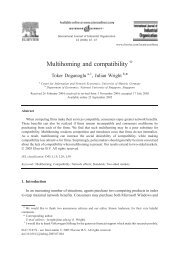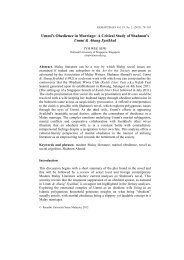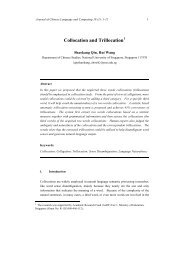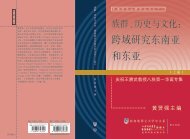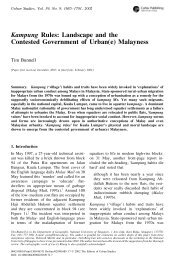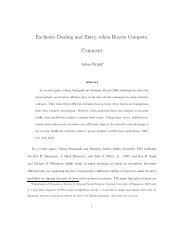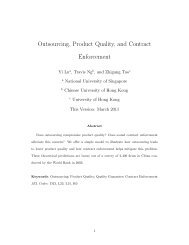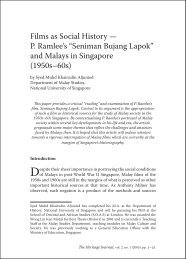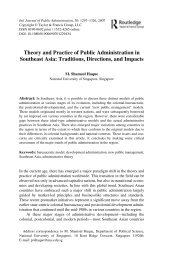Symbiotic production: The case of telecommunication ... - NUS - Home
Symbiotic production: The case of telecommunication ... - NUS - Home
Symbiotic production: The case of telecommunication ... - NUS - Home
You also want an ePaper? Increase the reach of your titles
YUMPU automatically turns print PDFs into web optimized ePapers that Google loves.
<strong>Symbiotic</strong> <strong>production</strong>: <strong>The</strong> <strong>case</strong> <strong>of</strong><br />
<strong>telecommunication</strong> pricing ∗<br />
Michael Carter<br />
Julian Wright<br />
Abstract<br />
In this paper we analyze a generalization <strong>of</strong> vertical monopolies<br />
in which monopoly suppliers trade essential inputs with one another.<br />
<strong>The</strong> most obvious applications <strong>of</strong> the model, which we call symbiotic<br />
<strong>production</strong>, are to postal and <strong>telecommunication</strong>s services. We<br />
show how producers can use per-unit tariffs to achieve cooperative<br />
outcomes without colluding directly over consumer prices. We then<br />
show the firms have an incentive to collude in the setting <strong>of</strong> tariffs but<br />
that such collusion will lower consumer prices. This assumes that<br />
the suppliers are otherwise unfettered. In contrast, if the constituent<br />
monopolies are regulated, we show that collusion enables the firms<br />
to completely undo the restraints <strong>of</strong> regulation. <strong>The</strong> model has important<br />
policy implications for the international <strong>telecommunication</strong>s<br />
market.<br />
Keywords: <strong>telecommunication</strong>s;network pricing;regulation<br />
Recently, the British newspaper, the Financial Times claimed to have uncovered<br />
arrangements among the world’s telephone companies to keep international<br />
telephone call charges artificially high. <strong>The</strong>se arrangements, based on<br />
obscure accounting practices, were said to be costing consumers $US10 billion<br />
per annum worldwide. 1<br />
<strong>The</strong> “obscure accounting practices” arise from the way in which international<br />
telephone callers are charged. An international call utilizes the services <strong>of</strong> a<br />
∗ Earlier versions <strong>of</strong> this paper were presented at the University <strong>of</strong> Canterbury and Zentrum<br />
fur Europaische Wirtschaftsforschung in Mannheim, where participants provided when<br />
useful comments. <strong>The</strong> authors also gratefully acknowledge the contribution <strong>of</strong> two anonymous<br />
referees, whose detailed comments helped to significantly clarify the final presentation<br />
1 <strong>The</strong> stakes are immense. Aronson and Cowley (1988, p7) cite a U.S. Department <strong>of</strong> Commerce<br />
report which estimates total world market for <strong>telecommunication</strong>s in 1990 as $US444<br />
billion which is approximately equal to the GNP <strong>of</strong> Canada. International telephone calls are<br />
the fastest growing component <strong>of</strong> <strong>telecommunication</strong>s market. We estimate that the international<br />
sector may now account for 25 percent <strong>of</strong> total revenue ($US115 billion per year) which<br />
is comparable to the GNP <strong>of</strong> Austria ($US126 billion).
telephone company at each end. Normally, the revenue for the call is collected<br />
by the originating telephone company from the party who initiates the call. <strong>The</strong><br />
company then compensates the other company for the costs it incurs in handling<br />
the call.<br />
<strong>The</strong>re is indeed an international cartel, the CCITT (International Telegraph<br />
and Telephone Consultative Committee), whose extensive rules govern the sharing<br />
<strong>of</strong> revenue between telephone companies. “<strong>The</strong> Recommendations <strong>of</strong> the<br />
CCITT are in effect the real international <strong>telecommunication</strong>s rules <strong>of</strong> today<br />
for, although they are not legally binding, they are nevertheless adhered to by<br />
most member nations” (Cullen, 1987). Following their last meeting in November<br />
1988, the CCITT published more than 50 volumes <strong>of</strong> recommendations relating<br />
to <strong>telecommunication</strong>s services, including one volume devoted entirely to comprehensive<br />
recommendations regarding the sharing <strong>of</strong> international call revenues<br />
(CCITT, 1988). <strong>The</strong>re, the CCITT recommends three alternative methods <strong>of</strong><br />
international reimbursement: (1) a flat-rate charge, (2) a per-unit charge or (3)<br />
equal division <strong>of</strong> the revenue. In practice, most countries adopt the per-unit<br />
charge “accounting rate” and these are normally set bilaterally at meetings between<br />
each pair <strong>of</strong> countries. In a companion piece (Carter and Wright, 1991),<br />
we discuss the CCITT recommendations and devise the optimal tariff structure<br />
which involves a combination <strong>of</strong> the three alternatives.<br />
Telephone services and other forms <strong>of</strong> <strong>telecommunication</strong>s services, such as<br />
telex, telegrams, and data exchange, involve a form <strong>of</strong> <strong>production</strong> which has the<br />
following characteristics<br />
• Each producer has monopoly power in its own market.<br />
• Each produces both an intermediate and a final good.<br />
• Each producer must purchase the intermediate good from the other producers.<br />
This market form has some parallels with the standard vertical integration<br />
model and can be seen as an extension in which the <strong>production</strong> links extend in<br />
both directions. This is illustrated schematically in Figure 1. We call this form<br />
symbiotic <strong>production</strong>. Other examples are postal services, the international floral<br />
delivery service (Interflora), and the cross-licensing <strong>of</strong> complementary technologies.<br />
In this paper we analyze a general model <strong>of</strong> symbiotic <strong>production</strong>, the most<br />
obvious applications <strong>of</strong> which are to postal and <strong>telecommunication</strong>s services.<br />
We show how producers can use per-unit tariffs to achieve cooperative outcomes<br />
without colluding directly over consumer prices. We then show the firms<br />
have an incentive to collude in the setting <strong>of</strong> tariffs but that such collusion will<br />
lower consumer prices. This is analogous to a standard result in industrial organization<br />
that vertical integration <strong>of</strong> a sequence <strong>of</strong> monopolies improves welfare<br />
(Tirole, 1988, p175). However, the extension to symbiotic <strong>production</strong> is not<br />
2
Firm 1<br />
Firm 2<br />
Vertical integration<br />
Firm 1<br />
Firm 2<br />
<strong>Symbiotic</strong> <strong>production</strong><br />
Figure 1: Comparing vertical integration and symbiotic <strong>production</strong>.<br />
immediate and we have allowed for complementarities to exist between the two<br />
monopolists. Furthermore, the results are not identical with those arising from<br />
vertical <strong>production</strong>. <strong>Symbiotic</strong> <strong>production</strong> allows each constituent firm have its<br />
own individual tariff. <strong>The</strong> firms can use simple per-unit tariffs to achieve both<br />
maximum joint pr<strong>of</strong>its and an acceptable division <strong>of</strong> pr<strong>of</strong>its. In comparison,<br />
vertically related firms require a more complicated tariff, such as a two-part<br />
tariff, to get an appropriate distribution <strong>of</strong> pr<strong>of</strong>its. This is important in practice,<br />
since the per-unit tariffs avoid the drawbacks <strong>of</strong> more complicated regimes.<br />
Finally, if the constituent monopolies are regulated, collusion enables the firms<br />
to completely undo the restraints <strong>of</strong> pr<strong>of</strong>it regulation.<br />
Our results have important implications for international <strong>telecommunication</strong>s<br />
markets. Contrary to allegations <strong>of</strong> the Financial Times, collusion over<br />
tariff setting may lower (rather than raise) consumer prices and enhance welfare.<br />
<strong>The</strong> <strong>telecommunication</strong>s cartel, the CCITT, may be good for consumers.<br />
Overcharging <strong>of</strong> international telephone calls arises from the local or national<br />
monopolization <strong>of</strong> supply and the CCITT helps to ameliorate the effects <strong>of</strong><br />
these multiple monopolies. Efficiency in <strong>telecommunication</strong>s will be enhanced<br />
by promotion <strong>of</strong> competition amongst providers nationally, while attempts to<br />
3
undermine the collusive activities <strong>of</strong> the CCITT, in the absence <strong>of</strong> competition<br />
amongst local suppliers, will only serve to produce greater inefficiency. On the<br />
other hand, given the continued existence <strong>of</strong> the CCITT and its revenue sharing<br />
system, attempts to improve national outcomes through regulation should<br />
be viewed with caution, since regulation may be <strong>of</strong>fset through international<br />
transactions.<br />
<strong>The</strong> paper is organized as follows. In Section 1, we set up the model and<br />
specify the assumptions. In Section 2, we characterize the pr<strong>of</strong>it opportunities<br />
available to the firms and derive our two fundamental propositions. Section 3<br />
considers the impact <strong>of</strong> collusion on consumer prices and welfare while Section<br />
4 deals with regulation. Conclusions are presented in Section 5.<br />
1 <strong>The</strong> model<br />
We will assume that there are only two firms which sell each other intermediate<br />
products. 2 <strong>The</strong> firms pr<strong>of</strong>it functions are:<br />
Π 1 = p 1 q 1 (p 1 ) − C 1 (q 1 ,d 1 )+T 1 (d 1 ) − T 2 (d 2 )<br />
Π 2 = p 2 q 2 (p 2 ) − C 2 (q 2 ,d 2 ) − T 1 (d 1 )+T 2 (d 2 )<br />
We use q i and d i to denote the demand for the final good and the intermediate<br />
good respectively produced by firm i while C i (q i ,d i ) denotes the costs incurred.<br />
T i denotes the revenue received by firm i for sales <strong>of</strong> the intermediate product<br />
to firm j. Each firms pr<strong>of</strong>it comprises revenue from final sales minus costs plus<br />
the net inter company transfer.<br />
It is clear that, by appropriate choice <strong>of</strong> the transfer functions T i ,firmscan<br />
achieve any division <strong>of</strong> the potential joint pr<strong>of</strong>it. In practice, for example in<br />
the international <strong>telecommunication</strong>s market, firms restrict themselves to linear<br />
tariffs, that is a fixed price per unit <strong>of</strong> intermediate good with no lump-sum<br />
transfer. In our companion paper (Carter and Wright, 1991), we discuss the<br />
rationale for this restriction. In this paper, we assume this restriction and<br />
explore its ramifications. Hence we assume:<br />
A1Tariffs are restricted to be linear, that is<br />
T i = t i d i i =1, 2<br />
where t i is the transfer price charged by firm i to firm j.<br />
2 This restriction is <strong>of</strong> limited practical significance, since tariffs in <strong>telecommunication</strong>s are<br />
typically set bilaterally. Furthermore, the extension <strong>of</strong> all our results to n firms is immediate,<br />
provided that the demand and cost functions are independent, that is firm i’s demand is<br />
independent <strong>of</strong> the price charged by firm j and the cost functions are separable. This extension<br />
is contained in a detailed appendix, which is available on request from the authors.<br />
4
<strong>The</strong> following fixed proportions technology is motivated by the principal<br />
application <strong>of</strong> the paper, namely international <strong>telecommunication</strong>s and postal<br />
services.<br />
A2Firm j’s demand for firm i’s intermediate good depends only on firm j’s<br />
desired output <strong>of</strong> its own good, that is<br />
d i = q j<br />
i, j =1, 2,i≠ j<br />
We also assume<br />
A3<strong>The</strong> demand functions q i and cost functions C i are twice continuously differentiable<br />
with bounded derivatives.<br />
Given these assumptions, the firms pr<strong>of</strong>it functions can be written as<br />
Π 1 (p 1 ,t 1 ,t 2 )=p 1 q 1 (p 1 ) − C 1 (q 1 ,q 2 )+t 1 q 2 − t 2 q 1<br />
Π 2 (p 2 ,t 1 ,t 2 )=p 2 q 2 (p 2 ) − C 2 (q 1 ,q 2 ) − t 1 q 2 + t 2 q 1<br />
In the absence <strong>of</strong> collaboration, we assume that the firms choose tariffs<br />
and consumer prices sequentially. In other words, the firms play a two stage<br />
noncooperative game. In the first stage, firms set tariffs. In the second stage,<br />
the firms set consumer prices to maximize individual firm pr<strong>of</strong>its taking the<br />
tariffs as given. This sequential structure is implicit in the recommendations <strong>of</strong><br />
the CCITT and reflects the practice in international <strong>telecommunication</strong>s, where<br />
tariffs are set in bilateral negotiations. In contrast, final output prices are set<br />
unilaterally and are much more readily changed than tariffs. 3<br />
In the second stage, firms set output prices to maximize pr<strong>of</strong>its. <strong>The</strong> outcome<br />
is the standard Nash equilibrium. <strong>The</strong> equilibrium prices are functions <strong>of</strong><br />
the tariff level. As tariffs vary, this function traces out a set <strong>of</strong> possible Nash<br />
equilibrium prices. We call this function the Nash equilibrium price mapping<br />
and denote it p ∗ (t). In the first stage, the firms set tariff levels assuming that<br />
consumer prices will be determined as above, that is according to the Nash<br />
equilibrium price mapping. <strong>The</strong> noncooperative equilibrium tariffs and the corresponding<br />
consumer prices constitute the Nash equilibrium <strong>of</strong> the two stage<br />
game.<br />
To avoid the complications <strong>of</strong> multiple equilibria we assume:<br />
A4<strong>The</strong> Nash equilibrium price mapping is a function (rather than a correspondence),<br />
that is<br />
p ∗ i (t) ∈ arg max Π i (p i ,t 1 ,t 2 ) is uniquely defined for all t =(t 1 ,t 2 )<br />
p i<br />
3 International telephone carriers in the U.S. change call prices frequently. For example,<br />
during the weekends <strong>of</strong> June 1993, MCI <strong>of</strong>fered substantial reductions on international calls<br />
to a large number <strong>of</strong> countries. It is unlikely that these were negotiated with all the network<br />
partners.<br />
5
and there is a unique Nash equilibrium, that is<br />
t ∗ i ∈ arg max Π i (p ∗ i (t),t i ) is uniquely defined.<br />
t i<br />
<strong>The</strong> Nash equilibrium <strong>of</strong> the two stage game is defined by (p ∗ 1(t ∗ 1,t ∗ 2),p ∗ 2(t ∗ 1,t ∗ 2)).<br />
A5At the Nash equilibrium, ∂q i /∂p i < 0 and q i > 0 for i =1, 2.<br />
A6At the Nash equilibrium, ∂ 2 C i /∂q i ∂d i ≤ 0 for i =1, 2.<br />
A7At the Nash equilibrium,<br />
∂ 2 Π i<br />
∂p 2 i<br />
< 0 for i, j =1, 2<br />
∂ 2 Π i<br />
∂p 2 i<br />
∂ 2 Π j<br />
∂p 2 j<br />
> ∂2 Π i ∂ 2 Π j<br />
∂p i ∂p j ∂p i ∂p j<br />
i ≠ j<br />
Assumptions A3, A4 and A7 are standard technical assumptions. Assumption<br />
A5 rules out the possibility <strong>of</strong> corner solutions, which seem empirically<br />
unlikely in the applications we envisage. Assumption A6 says that the firm’s<br />
marginal cost <strong>of</strong> producing the final good q i does not increase with the level <strong>of</strong><br />
<strong>production</strong> <strong>of</strong> the intermediate good. This assumption enables us to show that<br />
final good prices are weak strategic complements — each firm responds to more<br />
aggressive pricing by following suit. Alternatively, we could simply assume that<br />
prices are strategic complements, in which <strong>case</strong> we can relax the assumption<br />
that each firm is a monopolist in the local market. 4 This is not likely to be<br />
important in the applications we are considering here. An increase in the price<br />
<strong>of</strong> calls form New York to London may lead some regular callers to switch and<br />
have the other party initiate the call from London. However, this arbitrage<br />
effect is likely to be negligible.<br />
<strong>The</strong> essence <strong>of</strong> the model is illustrated in Figure 2, which shows the special<br />
<strong>case</strong> <strong>of</strong> linear demands and constant marginal costs. 5 Total pr<strong>of</strong>it <strong>of</strong> firm<br />
1 comprises the two shaded areas in Figure 2, being the pr<strong>of</strong>it (net <strong>of</strong> tariff)<br />
on the domestic market and the tariff revenue derived on the foreign market.<br />
Under the assumptions <strong>of</strong> the model, prices will be determined where marginal<br />
revenue equals marginal cost (including tariff) in each market. Given this pricing<br />
behavior, each firm will act so as to maximize the tariff revenue received<br />
from the foreign firm, which will be achieved by maximizing the area under the<br />
marginal revenue curve <strong>of</strong> the foreign firm. <strong>The</strong> firm’s objective is to maximize<br />
the sum <strong>of</strong> both areas. <strong>The</strong> assumption that they make tariff and price decisions<br />
sequentially is essentially that they treat these two areas independently.<br />
<strong>The</strong> general model requires more sophisticated analysis, but the basic insight<br />
remains. <strong>The</strong> analysis <strong>of</strong> the general model is taken up in the next section.<br />
4 This was done in an earlier version <strong>of</strong> the paper which is available from the authors on<br />
request.<br />
5 Non-tariff marginal costs are assumed to be zero in drawing Figure 2.<br />
6
p,t<br />
Firm 1<br />
Firm 2<br />
p<br />
p<br />
2<br />
1<br />
Demand<br />
t 2<br />
MR<br />
p,t<br />
t 1<br />
MR<br />
Demand<br />
q<br />
q<br />
Figure 2: Linear demands, constant marginal costs.<br />
2 Characterization <strong>of</strong> the pr<strong>of</strong>it possibilities<br />
<strong>The</strong> central results <strong>of</strong> the paper flow from the following two propositions.<br />
Proposition 1 Assume (A1) – (A5) and (A7). Any final good prices ˜p 1 and ˜p 2<br />
which yield non-negative pr<strong>of</strong>its to each firm can be obtained by noncooperative<br />
pricing behavior by appropriate choices <strong>of</strong> t 1 and t 2 .<br />
Pro<strong>of</strong> — see Appendix.<br />
Proposition 1 shows that the firms lose nothing by choosing tariffs and prices<br />
sequentially. It establishes that the benefits <strong>of</strong> collusive pricing can be achieved<br />
by setting tariffs collusively and then setting prices non-cooperatively according<br />
to p ∗ (t). <strong>The</strong> firms can indirectly collude over consumer prices by colluding over<br />
transfer prices. <strong>The</strong> second proposition shows that the firms have an incentive<br />
to collude over transfer prices.<br />
Proposition 2 Assuming (A1) – (A7), the Nash equilibrium is Pareto inefficient.<br />
That is, both firms can be made better <strong>of</strong>f by appropriate choice <strong>of</strong> tariffs,<br />
given that consumer prices are set non-cooperatively.<br />
Pro<strong>of</strong> — see Appendix.<br />
7
Π 2<br />
H<br />
M = M '<br />
N<br />
F(p)<br />
45<br />
F(p(t),t)<br />
o<br />
Π<br />
1<br />
Figure 3: Pr<strong>of</strong>it possibilities for symmetric firms.<br />
<strong>The</strong> intuition for this result is similar to the double marginalization externality<br />
in vertically related firms — a reduction in one firm’s tariff causes only a<br />
second order loss <strong>of</strong> its own pr<strong>of</strong>its but a first order increase in the other firm’s<br />
pr<strong>of</strong>its. <strong>The</strong> main extension here is that the double marginalization principle<br />
continues to hold with symbiotic <strong>production</strong> and when complementarities exist<br />
between firms.<br />
For the general <strong>case</strong> we illustrate the pr<strong>of</strong>it possibilities in Figures 3 and<br />
4. Let F (p) denote the pr<strong>of</strong>it possibility frontier where the firms can choose<br />
any prices while tariffs are constrained to zero (no inter company transfers).<br />
Let F (p ∗ (t),t) denote the pr<strong>of</strong>it possibility frontier where the firms choose any<br />
tariffs while prices are chosen noncooperatively given the tariffs. In other words,<br />
F (p ∗ (t),t) is the image <strong>of</strong> the Nash equilibrium price mapping in pr<strong>of</strong>it space.<br />
Let M and M ′ denote the points along F (p) andF (p ∗ (t),t) respectively at<br />
which joint pr<strong>of</strong>its are maximized. Finally, let N denote the Nash equilibrium<br />
outcomedefinedinSection2.<br />
Consider first the special <strong>case</strong> in which the firms have identical pr<strong>of</strong>it functions<br />
(Figure 3). By Proposition 1, the firms can choose (linear) tariffs which<br />
yield the joint pr<strong>of</strong>it-maximizing outcome. Since the firms are identical, these<br />
8
Π 2<br />
M<br />
H<br />
N<br />
M '<br />
F(p)<br />
45<br />
o<br />
F(p(t),t)<br />
Π 1<br />
Figure 4: Pr<strong>of</strong>it possibilities for asymmetric firms.<br />
tariffs imply no re-distribution <strong>of</strong> pr<strong>of</strong>its compared with point M. Thus points<br />
M and M ′ coincide for identical firms. Proposition 2 implies that N lies in the<br />
interior <strong>of</strong> F (p ∗ (t),t).<br />
One way <strong>of</strong> understanding Figures 3 and 4 is as depicting the different constraints<br />
imposed by restricting the tariff regimes. <strong>The</strong> least restrictive regime involving<br />
general tariff functions T i (d i ) generates the linear pr<strong>of</strong>it frontier H, since<br />
the best the firms can do is to redistribute the joint maximum pr<strong>of</strong>it M through<br />
lump sum transfers. Restricting the firms to linear tariffs does not constrain the<br />
pr<strong>of</strong>it opportunities provided the firms can price accordingly. <strong>The</strong> firms can still<br />
achieve the joint maximum pr<strong>of</strong>it and then mimic lump sum transfers by suitable<br />
choice <strong>of</strong> tariff levels. Linear tariffs do constrain pr<strong>of</strong>it opportunities if firms<br />
also act independently in setting prices given tariffs F (p ∗ (t),t). Alternatively,<br />
pr<strong>of</strong>it opportunities are constrained if tariffs are precluded altogether.<br />
<strong>The</strong> pr<strong>of</strong>it possibility frontiers for non-identical firms are illustrated in Figure<br />
4. By Proposition 1, there exist linear tariffs which imply the joint pr<strong>of</strong>it<br />
maximizing prices (with independent pricing) and achieve the same total pr<strong>of</strong>it,<br />
although with a different distribution between the firms. Hence points M and<br />
M ′ must lie on the same hyperplane, though in general they will not coincide.<br />
9
It follows that the pr<strong>of</strong>it possibility frontiers under the two regimes F (p) and<br />
F (p ∗ (t),t) will only partially overlap as shown in Figure 4. While both firms<br />
would benefit from a general tariff regime (including lump-sum transfers), their<br />
interests in the two alternative restricted regimes are conflicting. Again we note<br />
that N lies in the interior <strong>of</strong> F (p ∗ (t),t) by Proposition 2.<br />
It is not necessarily the <strong>case</strong> that M ′ is Pareto-superior to N. For example, if<br />
one firm was very much smaller than the other, it might do better by exploiting<br />
the bigger firm’s demand at the Nash equilibrium N than cooperating over<br />
tariffs at M ′ . This observation may have relevance for the trading between<br />
telephone systems <strong>of</strong> vastly different sizes. 6<br />
Figure 3 suggests that, with symmetric conditions, firms will lose nothing by<br />
relying on linear tariffs (rather than more general tariff structures) and pricing<br />
non-cooperatively provided they cooperate on the tariff levels. 7 Figure 4 suggests<br />
that this regime may also be reasonable with asymmetric firms, provided<br />
the asymmetries are not excessive. This point illustrates another key difference<br />
between vertical integration and symbiotic <strong>production</strong>. In the former, linear<br />
tariffs are inadequate for the dual tasks <strong>of</strong> maximizing total pr<strong>of</strong>its and redistributing<br />
pr<strong>of</strong>its. In symbiotic <strong>production</strong>, the use <strong>of</strong> two transfer prices allows<br />
both roles to be achieved with linear tariffs. This is important because it avoids<br />
any need to rely on franchise fees or price maintenance, which have serious<br />
drawbacks when there is uncertainty or private information (see Tirole, 1988,<br />
p176).<br />
<strong>The</strong> pr<strong>of</strong>it possibilities for vertically related firms are depicted in Figure 5,<br />
where F (p(t),t) represents the pr<strong>of</strong>it possibility frontier where the downstream<br />
firm (2’s) output price p(t) is conditional on the intermediate price t charged by<br />
firm 1. <strong>The</strong> point N is the optimal linear tariff for firm 1 — the non-cooperative<br />
equilibrium. <strong>The</strong> externality due to double marginalization is represented by<br />
the distance between the F (p(t),t) locus and the 45 degree line. This shows the<br />
inadequacy <strong>of</strong> linear tariffs to eliminate the double marginalization externality<br />
in vertically related firms.<br />
3 <strong>The</strong> effect <strong>of</strong> collusion on prices<br />
In 1990, the Financial Times alleged that, in colluding over tariffs, the world’s<br />
telephone companies were able to artificially raise consumer prices and extract<br />
an additional $US10 billion in revenue worldwide. Our analysis so far suggests<br />
that the telephone companies have a powerful incentive to collude since the Nash<br />
equilibrium is inefficient. However, contrary to these allegations, our results<br />
6 We understand that Australia has tried unsuccessfully to persuade small Pacific nations<br />
to lower bilateral tariffs. <strong>The</strong> Financial Times notes that some newly industrialized countries,<br />
which export many workers to richer economies who then call home, have proved very resistant<br />
to negotiating lower tariffs. In a future paper, we plan to explore the specific implications <strong>of</strong><br />
asymmetry and test these empirically.<br />
7 Of course if the firms are symmetric, net tariffs will be zero under all regimes.<br />
10
Π<br />
2<br />
H<br />
F(p(t),t)<br />
N<br />
45<br />
o<br />
Π 1<br />
Figure 5: Pr<strong>of</strong>it possibilities for vertically integrated firms.<br />
suggest that collusion over tariffs will in fact lower prices and benefit consumers.<br />
Starting from the Nash equilibrium N, firms increase their pr<strong>of</strong>its by jointly<br />
lowering rather than raising tariffs. Assuming that the firms continue to price<br />
independently, lower tariffs lead to lower prices and greater benefit to consumers.<br />
We formalize this result in the following proposition.<br />
Proposition 3 Given assumptions (A1) – (A7) and independent pricing behavior,<br />
collusion over tariffs will lead to lower prices.<br />
Pro<strong>of</strong> — see Appendix.<br />
<strong>The</strong> intuition here is analogous to the elimination <strong>of</strong> double marginalization<br />
through vertical integration (see for example Tirole, 1988, p174-175). In this<br />
<strong>case</strong> the double marginalization effect works both ways and both firms have an<br />
incentive to remove it. In other words, the firms impose an externality on each<br />
other through tariffs and this externality is reflected in consumer prices. Collusion<br />
enables internalization <strong>of</strong> the externality and a corresponding reduction in<br />
costs and consumer prices.<br />
11
4 <strong>The</strong> effects <strong>of</strong> regulation on prices<br />
Proposition 1 showed that firms can effectively collude over prices by colluding<br />
over tariffs while setting prices independently. <strong>The</strong> essence <strong>of</strong> this result carries<br />
over to regulated firms, provided that the regulated prices depend in some<br />
way upon tariffs. 8 Suitable examples include marginal cost pricing, average<br />
cost pricing and average variable cost pricing. <strong>The</strong> intuition is straightforward.<br />
Proposition 1 characterized attainable prices assuming that they were a given<br />
function <strong>of</strong> tariffs, namely the Nash equilibrium price mapping. <strong>The</strong> generalization<br />
asserts that the proposition holds for any univalent tariff-price relationship.<br />
In order to compare the prices chosen in the regulated and unregulated <strong>case</strong>s<br />
under linear tariffs, we would have to determine the outcome <strong>of</strong> bargaining in<br />
each <strong>case</strong>. We can abstract from the bargaining problem by assuming identical<br />
firms. Thus, in order to illustrate the more general result, we consider the<br />
effectiveness <strong>of</strong> marginal cost pricing in the symmetric <strong>case</strong>. This yields the<br />
following proposition.<br />
Proposition 4 Assuming (A1) – (A4) and identical firms, marginal cost pricing<br />
regulations are completely ineffectual.<br />
Pro<strong>of</strong> — see Appendix.<br />
<strong>The</strong> firms can completely undo the effect <strong>of</strong> cost-based regulations on their<br />
output markets by appropriately setting transfer prices on their input markets.<br />
Furthermore, the result trivially extends to the <strong>case</strong> <strong>of</strong> two-part tariffs<br />
even when the firms’ pr<strong>of</strong>it functions or bargaining powers differ. Finally, it is<br />
worth noting that, in the <strong>case</strong> <strong>of</strong> two-part tariffs, the result is not restricted to<br />
symbiotic <strong>production</strong>. For example, in the standard vertical relationship, regulations<br />
on the downstream firm can be completely negated through the use <strong>of</strong><br />
an appropriate two-part tariff by the upstream firm. 9 To make regulations effectual<br />
would require international cooperation between regulatory authorities,<br />
who could bilaterally agree to keep tariffs constrained to marginal cost. <strong>The</strong>y<br />
could then enforce marginal cost pricing unilaterally in each country. 10<br />
While collusion amongst telephone companies appears beneficial for consumers<br />
in an unregulated environment, this outcome may be reversed when<br />
the firms are regulated. This suggests a need for international coordination<br />
8 If this were not the <strong>case</strong>, in for example the <strong>case</strong> <strong>of</strong> international <strong>telecommunication</strong>s, a<br />
decision to regulate in country i could allow country j to extract all the rents through an<br />
appropriate linear tariff. This would be the <strong>case</strong> unless the regulators in the two countries<br />
could coordinate their regulations.<br />
9 Spulber (1989, p.277) notes that regulations can be undermined in a vertically integrated<br />
firm.<br />
10 As countries deregulate their <strong>telecommunication</strong>s industries, regulated firms will fewer<br />
regulated partners with which to trade. <strong>The</strong>ir regulated prices will be more exposed to being<br />
undone by the other unregulated firms in other countries. This should reduce the pay<strong>of</strong>f to<br />
regulation and perhaps hasten the spread <strong>of</strong> deregulation.<br />
12
on competition in and regulation <strong>of</strong> <strong>telecommunication</strong>s. Individual countries<br />
regulatory efforts may be undermined by the international cartel.<br />
5 Conclusion<br />
<strong>Symbiotic</strong> <strong>production</strong> occurs when two or more firms sell each other essential<br />
intermediate goods. Important examples involve international <strong>telecommunication</strong>s<br />
and postal services. In the <strong>case</strong> <strong>of</strong> two firms, we showed that collusion<br />
between the firms may be good for consumers and that price regulation may be<br />
ineffective.<br />
6 Appendix 11<br />
Pro<strong>of</strong> <strong>of</strong> Proposition 1.<br />
order conditions<br />
(p ∗ 1 ,p∗ 2 ) are determined for given (t 1,t 2 ) by the first<br />
∂Π 1<br />
=0<br />
∂p 1<br />
(1)<br />
∂Π 2<br />
=0<br />
∂p 2<br />
(2)<br />
Evaluate (1) and (2) at (˜p 1 , ˜p 2 ). <strong>The</strong>n solve for the resulting (t 1 ,t 2 ). Denote<br />
these (˜t 1 , ˜t 2 ). (A3) and (A5.1) guarantee the existence <strong>of</strong> (˜t 1 , ˜t 2 )asgiven.(A4)<br />
ensures the solution (p ∗ 1 ,p∗ 2 ) to (1) and (2), for those values (˜t 1 , ˜t 2 )isequalto<br />
(˜p 1 , ˜p 2 ) as required.<br />
✷<br />
Pro<strong>of</strong><strong>of</strong>Proposition2. Let Π ∗ i =Π i(p ∗ i ,p∗ j ). <strong>The</strong> Nash equilibrium is characterized<br />
by the first-order conditions<br />
dΠ ∗ i<br />
dt i<br />
≡ ∂Π∗ i<br />
∂p i<br />
∂p i<br />
∂t i<br />
+ ∂Π∗ i<br />
∂t i<br />
+ ∂Π∗ i<br />
∂p j<br />
∂p j<br />
∂t i<br />
=0, i,j =1, 2,i≠ j (3)<br />
Rearranging (3), noting ∂Π ∗ i /∂p i =0gives<br />
∂Π ∗ i<br />
∂p j<br />
= − ∂Π∗ i /∂t i<br />
∂p j /∂t i<br />
(4)<br />
Similarly<br />
dΠ ∗ i<br />
dt j<br />
≡ ∂Π∗ i<br />
∂p i<br />
∂p i<br />
∂t j<br />
+ ∂Π∗ i<br />
∂t j<br />
+ ∂Π∗ i<br />
∂p j<br />
∂p j<br />
∂t j<br />
(5)<br />
11 This appendix contains abbreviated pro<strong>of</strong>s for the propositions in the paper. A longer<br />
appendix containing detailed pro<strong>of</strong>s and extensions <strong>of</strong> the propositions for n firms is available<br />
on request from the authors.<br />
13
Substituting (4) into (5), noting ∂Π ∗ i /∂p i =0,gives<br />
dΠ ∗ i<br />
dt j<br />
= −q i − q j<br />
∂p j /∂t j<br />
∂p j /∂t i<br />
(6)<br />
Totally differentiating the first-order conditions and using A5, A6 and A7<br />
we get<br />
∂p i<br />
∂t i<br />
≥ 0<br />
i =1, 2and ∂p i<br />
∂t j<br />
> 0 i, j =1, 2,i≠ j (7)<br />
Note we use A5 and A6 to show ∂ 2 Π ∗ i /∂p i∂p j ≥ 0 in this step.<br />
At the Nash equilibrium dΠ ∗ i /dt i =0,i =1, 2. Also from (6), (7) and A5,<br />
dΠ ∗ i<br />
dt j<br />
< 0, i, j =1, 2,i≠ j. From the Nash equilibrium, a simultaneous reduction<br />
in tariffs will increase the pr<strong>of</strong>its <strong>of</strong> both firms.<br />
✷<br />
Pro<strong>of</strong> <strong>of</strong> Proposition 3. This follows immediately from Proposition 2 and<br />
equation (7).<br />
✷<br />
Pro<strong>of</strong><strong>of</strong>Proposition4. We have already seen in Section 3 that, in the absence<br />
<strong>of</strong> regulation, identical firms would choose prices which maximised their joint<br />
pr<strong>of</strong>it. Under marginal cost pricing, the regulated price loci are:<br />
p R 1 = ∂C 1<br />
+ t 2<br />
∂q 1<br />
(8)<br />
p R 2 = ∂C 2<br />
+ t 1<br />
∂q 2<br />
(9)<br />
Since ∂C i /∂q i , i =1, 2 is bounded, the firms can achieve any prices by appropriate<br />
choice <strong>of</strong> t 1 and t 2 . Identical firms will indeed choose t 1 and t 2 so as<br />
to attain the joint pr<strong>of</strong>it maximizing outcome. <strong>The</strong>se t 1 and t 2 will then lead<br />
under the regulations to the desired prices (provided the tariff-price relationship<br />
is univalent).<br />
✷<br />
14
7References<br />
Aronson, John D. and Peter F. Cowhey (1988) When Countries Talk: International<br />
Trade in Telecommunications Services. Cambridge, Mass.: Ballinger.<br />
“Called to account: International telephone calls still cost too much”, <strong>The</strong><br />
Economist (24 April 1993)<br />
Carter, Michael and Julian Wright (1991) “Optimal Telecommunications Tariffs<br />
and the CCITT,” Telecommunication Journal, 59, pp. 125-131.<br />
CCITT (1988) General Tariff Principles: Charging and Accounting in International<br />
Telecommunications Services - Series D Recommendations. Belgium:<br />
International Telecommunications Union (Blue Book, Volume II - Fascicle<br />
II.1)<br />
Cullen, B. (1987) “Regulation and the User,” Telecommunication Journal, 54,<br />
pp. 180-186.<br />
Dixon, Hugo (1990) “Reconnecting Charges With Costs,” Financial Times, 3<br />
April 1990, p. 20.<br />
Littlechild, Stephen (1979) Elements <strong>of</strong> Telecommunications Economics. London<br />
& New York: Institution <strong>of</strong> Electrical Engineers.<br />
Spulber, Daniel F. (1989) Regulation and Markets.<br />
Press.<br />
Cambridge, Mass.: MIT<br />
Tirole, Jean (1988) <strong>The</strong> <strong>The</strong>ory <strong>of</strong> Industrial Organization. Cambridge, Mass.:<br />
MIT Press.<br />
15



